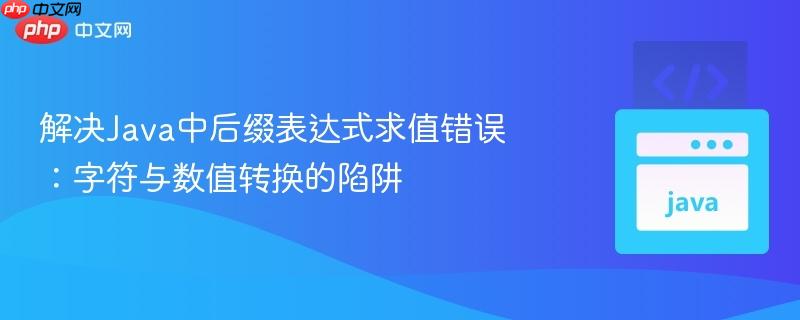
本文深入探讨了java中实现后缀表达式求值时常见的错误源——字符与数值的转换问题。当直接将字符型数字强制转换为浮点数时,会错误地使用其ascii值而非实际数值。文章详细解释了这一陷阱,提供了通过减去字符'0'进行正确转换的方法,并结合完整的java代码示例,确保后缀表达式能够准确计算,同时提示了多位数处理和错误处理等扩展考量。
后缀表达式(PostFix Expression),也称为逆波兰表示法,是一种无需括号即可表示运算的数学表达式。它的求值过程通常依赖于栈(Stack)数据结构:遇到操作数就入栈,遇到操作符就从栈中取出所需数量的操作数进行运算,然后将结果入栈。当表达式遍历完毕,栈中剩下的唯一元素就是最终结果。
以下是实现后缀表达式求值的基本Java代码结构:
import java.util.Stack;
public class PostFixEvaluate {
// 辅助方法:判断字符是否为操作数
public static boolean isOperand(char c) {
switch (c) {
case '+':
case '-':
case '*':
case '/':
return false; // 是操作符
default:
return true; // 是操作数
}
}
// 辅助方法:执行具体运算
public static float calculate(Float operand_1, char operator, Float operand_2) {
switch (operator) {
case '+':
return operand_2 + operand_1;
case '-':
return operand_2 - operand_1;
case '*':
return operand_2 * operand_1;
case '/':
if (operand_1 == 0) { // 避免除以零
throw new ArithmeticException("Division by zero");
}
return operand_2 / operand_1;
}
return 0; // 默认返回,实际应抛出异常
}
// 后缀表达式求值主方法
public static float postFixEvaluation(String expr) {
Stack<Float> stack = new Stack<>();
int index = 0;
while (index < expr.length()) {
char token = expr.charAt(index);
if (isOperand(token)) { // 如果是操作数
// 核心问题所在:字符到数值的转换
// float operandIn = (float)token;
// stack.push(operandIn);
} else { // 如果是操作符
float a = stack.pop(); // 第一个弹出的操作数 (右操作数)
float b = stack.pop(); // 第二个弹出的操作数 (左操作数)
stack.push(calculate(a, token, b));
}
index += 1;
}
return stack.pop(); // 最终结果
}
}在上述代码的 postFixEvaluation 方法中,当遇到数字字符时,原始实现通常会尝试直接将其转换为浮点数:
if(isOperand(token)){
float operandIn = (float)token; // 问题所在行
stack.push(operandIn);
}这里隐藏着一个常见的陷阱:在Java中,将 char 类型直接强制转换为 float(或 int)时,它不会将其视为代表的数字值,而是会使用该字符的ASCII(或Unicode)码值。
立即学习“Java免费学习笔记(深入)”;
例如,字符 '3' 的ASCII码是 51。因此,(float)'3' 的结果是 51.0f,而不是我们期望的 3.0f。对于一个形如 "312*+" 的后缀表达式,如果直接进行这种转换,'3' 会被识别为 51,'1' 为 49,'2' 为 50。这将导致计算结果与预期大相径庭。这也是为什么输入 312*+456*+97-/+ 会得到 3958.0 这种巨大偏差的原因。
要将字符型的数字(如 '0' 到 '9')转换为其对应的数值,我们需要利用字符的ASCII码是连续的这一特性。通过将字符数字减去字符 '0',可以得到其整数值。
例如:
因此,修正后的操作数入栈代码应为:
if(isOperand(token)){
stack.push((float)(token - '0')); // 正确的字符到数值转换
}在 postFixEvaluation 方法中,操作数从栈中弹出的顺序和传递给 calculate 方法的参数顺序至关重要。
float a = stack.pop(); // 第一个弹出的操作数,对应后缀表达式中的右操作数 float b = stack.pop(); // 第二个弹出的操作数,对应后缀表达式中的左操作数 stack.push(calculate(a, token, b));
calculate 方法的签名是 public static float calculate(Float operand_1, char operator, Float operand_2 )。这意味着 a 被传入 operand_1,b 被传入 operand_2。
在 calculate 方法内部:
这与后缀表达式的求值规则完全一致:第二个弹出的操作数(b,即左操作数)在前,第一个弹出的操作数(a,即右操作数)在后。因此,原始代码中的 calculate 方法及其参数传递方式是正确的。
结合上述分析,以下是修正后的 PostFixEvaluate 类,可以正确处理单字符数字的后缀表达式求值:
import java.util.Stack;
public class PostFixEvaluate {
/**
* 执行两个操作数的运算
* @param operand_1 右操作数(第一个从栈中弹出)
* @param operator 运算符
* @param operand_2 左操作数(第二个从栈中弹出)
* @return 运算结果
*/
public static float calculate(Float operand_1, char operator, Float operand_2) {
switch (operator) {
case '+':
return operand_2 + operand_1;
case '-':
return operand_2 - operand_1;
case '*':
return operand_2 * operand_1;
case '/':
if (operand_1 == 0) {
throw new ArithmeticException("Error: Division by zero.");
}
return operand_2 / operand_1;
default:
throw new IllegalArgumentException("Error: Invalid operator " + operator);
}
}
/**
* 判断字符是否为操作数
* @param c 待判断字符
* @return 如果是操作数返回true,否则返回false
*/
public static boolean isOperand(char c) {
// 判断是否为数字字符
return c >= '0' && c <= '9';
}
/**
* 对后缀表达式进行求值
* @param expr 后缀表达式字符串
* @return 表达式的计算结果
*/
public static float postFixEvaluation(String expr) {
Stack<Float> stack = new Stack<>();
for (int i = 0; i < expr.length(); i++) {
char token = expr.charAt(i);
if (isOperand(token)) { // 如果是操作数
// 关键修正:将字符数字转换为其对应的数值
stack.push((float)(token - '0'));
} else { // 如果是操作符
if (stack.size() < 2) {
throw new IllegalArgumentException("Error: Invalid postfix expression - not enough operands for operator " + token);
}
float operand_right = stack.pop(); // 第一个弹出的,作为右操作数
float operand_left = stack.pop(); // 第二个弹出的,作为左操作数
stack.push(calculate(operand_right, token, operand_left));
}
}
if (stack.size() != 1) {
throw new IllegalArgumentException("Error: Invalid postfix expression - too many operands or operators.");
}
return stack.pop();
}
public static void main(String[] args) {
// 原始问题中的测试用例
String expression = "312*+456*+97-/+";
try {
float result = postFixEvaluation(expression);
System.out.println("The result of \"" + expression + "\" is: " + result); // 预期输出 22.0
} catch (Exception e) {
System.err.println(e.getMessage());
}
// 其他测试用例
try {
System.out.println("Result of \"12+3*\" is: " + postFixEvaluation("12+3*")); // (1+2)*3 = 9
System.out.println("Result of \"42/\" is: " + postFixEvaluation("42/")); // 4/2 = 2
System.out.println("Result of \"512+4*+3-\" is: " + postFixEvaluation("512+4*+3-")); // 5 + (1+2)*4 - 3 = 5 + 12 - 3 = 14
} catch (Exception e) {
System.err.println(e.getMessage());
}
}
}使用修正后的代码运行 312*+456*+97-/+,将得到正确的结果 22.0。
通过理解字符与数值转换的细节,并注意操作数顺序和潜在的扩展问题,可以构建出准确且健壮的后缀表达式求值器。
以上就是解决Java中后缀表达式求值错误:字符与数值转换的陷阱的详细内容,更多请关注php中文网其它相关文章!

每个人都需要一台速度更快、更稳定的 PC。随着时间的推移,垃圾文件、旧注册表数据和不必要的后台进程会占用资源并降低性能。幸运的是,许多工具可以让 Windows 保持平稳运行。

Copyright 2014-2025 https://www.php.cn/ All Rights Reserved | php.cn | 湘ICP备2023035733号